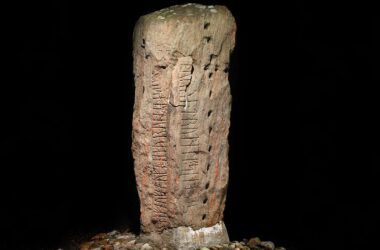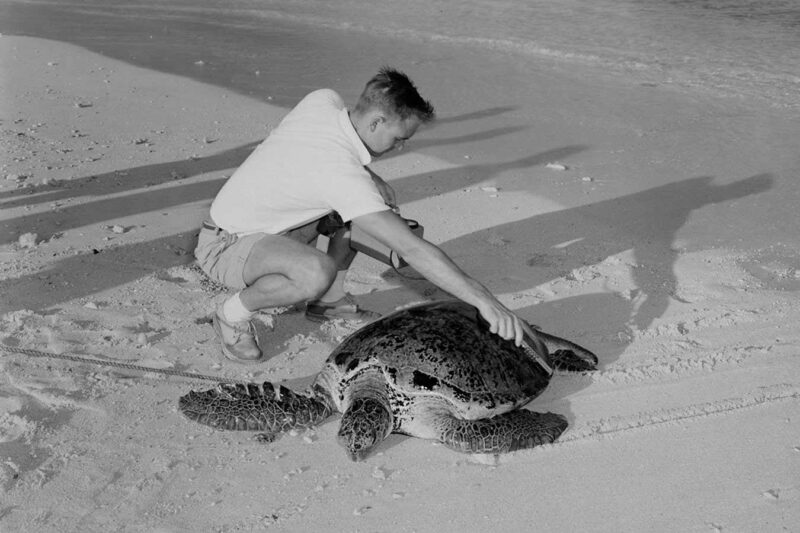A turtle being examined for potential radioactivity in the Marshall Islands in 1957
National Archives
Tortoises and turtles have been found to carry a radioactive contamination history dating back decades on their backs.
The reptiles store radioactive uranium isotopes in their shell scales after being exposed to fallout from nuclear weapons testing or unintentional waste discharges. This discovery may have applications in the long-term tracking of radionuclides, or naturally occurring radioactive variants of elements.
Nuclear waste radioactive elements disperse widely and remain in the environment for extended periods of time. It is believed that historical nuclear activities have contaminated up to 80 million cubic metres of soil and 4.7 billion cubic metres of water in the United States alone.
There are difficulties in detecting radioactive accumulation in organisms, as Cyler Conrad of the Pacific Northwest National Laboratory in Washington state explains. Tree rings, for example, can store radionuclides because they form in a predictable order. However, he argues that the rings are not a valid chronology since components might diffuse in the wood between them.
Conrad and his colleagues speculated that the strong scales known as scutes that form on the shells of turtles and tortoises would be a more viable option. These, too, develop progressively, but the nail-like scale material is essentially dated the moment it is deposited and becomes distinct from other physiological tissues.
The researchers took scute samples from four different species of turtles from two separate locations, all of which had been exposed to radioactive elements in the past. A green sea turtle (Chelonia mydas) from the Marshall Islands and a Mojave desert tortoise (Gopherus agassizii) from Nevada were the two reptiles used as test subjects. In the middle of the twentieth century, nuclear bombs were tested at both locations.
The other two turtles were found in fuel processing sites, which release radioactive waste into the environment. The scientists also studied a desert tortoise from a region with no history of nuclear testing.
Chemical examinations of shell fragments from four turtles found at former nuclear facilities revealed low but significantly higher quantities of uranium radionuclides. The uranium signal in the scute growth rings of a local eastern box turtle (Terrapene carolina carolina) matched with the years 1955 to 1962, when trash was released into the air from the Oak Ridge National Laboratory in Tennessee.
These rambling uranium chronicles may help the team piece together the history of nuclear pollution in ecosystems, they say.
Researchers “assess the concentration of radionuclides in feathers, bones, and other tissues in specimens collected before and after nuclear tests and accidents,” says Germán Orizaola of the University of Oviedo in Spain, so this study could pave the way for a new field of radioecology research using zoological collections in museums.
Clare Bradshaw from Stockholm University in Sweden speculates that the approach may be employed relatively non-invasively on living turtles and tortoises given that the researchers only needed a very little sample of shell tissue for their studies.
This was also one of Conrad’s proposed uses for the research. Is it true that [radionuclides] are still being accumulated by the turtles? Can they be quantified and researched to shed light on the state of the modern world?
FAQs
- How do tortoises and turtles carry a radioactive contamination history?
- They store radioactive uranium isotopes in their shell scales after being exposed to nuclear weapons testing fallout or unintentional waste discharges.
- What could be the applications of this discovery?
- The discovery may have applications in long-term radionuclide tracking and understanding the impact of nuclear pollution on ecosystems.
- Why is it difficult to detect radioactive accumulation in organisms?
- Radioactive accumulation in organisms is challenging to detect due to factors like diffusion within tissues. Traditional methods like tree rings might not provide accurate chronology.
- Why are turtle shell scales considered a viable option for studying radioactive accumulation?
- Turtle shell scales, known as scutes, are a viable option because their material is essentially dated the moment it is deposited and becomes distinct from other physiological tissues.
- How did researchers study the radioactive contamination history in turtles?
- Researchers collected scute samples from turtles exposed to radioactive elements. Chemical examinations of shell fragments revealed higher quantities of uranium radionuclides in turtles from nuclear facilities.







